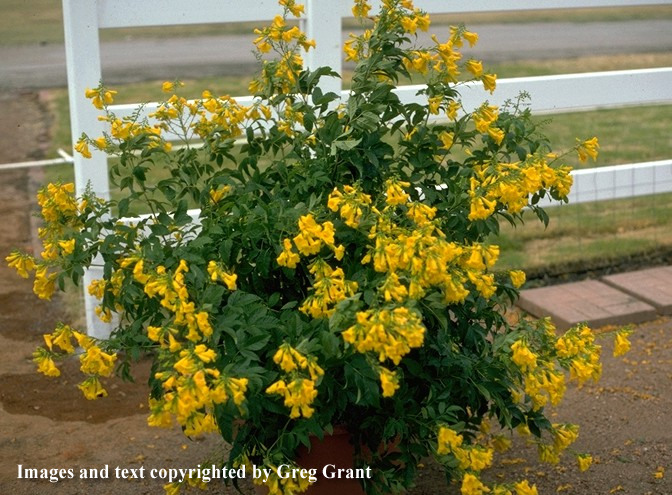
Tecoma stans 'GoldStar'
Gold Star Esperanza
Tecoma stans 'Gold Star'
(Esperanza, Yellow Bells, Yellow Alder)
Heat and sun loving tropical with golden-yellow
bell shaped flowers from late spring till frost.
Zone 9.
Exposure: Full sun
Size: Three to four feet as an annual.
Blooms: Lightly fragrant, golden yellow, spring till frost.
Uses: Container, specimen, bedding, xeriscape, etc.
Notes: Remove seed pods to promote faster rebloom. Texas native. 1999
Texas A&M CEMAP promotion.
'Gold Star' Esperanza is
a selection I made from a private garden in San Antonio.
It was introduced by Lone Star Growers. 'Gold Star' was selected
because it was the earliest blooming Tecoma stans that
I trialed. Previously, Esperanza was difficult to sell as it didn't produce blooms
in the container until late in the season. 'Gold
Star' actually produced them as a liner.
Tecoma stans requires bright
light and warm temperatures. It is propagated by
softwood cuttings under mist. Bottom heat is recommended. I generally
use a 3,000 ppm IBA quick dip to promote better rooting.
This particular selection
is intermediate between the West Texas Tecoma stans
angustata and the tropical Tecoma stans stans. Flower and leaf size
is intermediate between the two.
Although grown as a shrub
and a perennial in San Antonio, South Texas, and
Mexico, Esperanza works best in the nursery trade as a tropical
container plant, similar to Hibiscus, Bougainvillea, and
Mandevilla. It isgenerally sold in one gallon or three gallon containers.
Esperanza has relatively
few pests. In the greenhouse, it can be attacked by
spider mites and aphids. Outdoors it is generally pest free. Too keep
the plants tidy and continuously blooming in the landscape,
it is recommended that the clusters of seed pods ("green beans") be cut off.
All selections of Tecoma
stans are uniquely adapted to hot sunny Texas summers.
'Gold Star' provides a more marketable plant however.
For more information on these and other adapted
plants for Texas landscape see the following websites:
TAMU: http://aggie-horticulture.tamu.edu/cemap/



